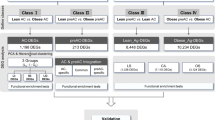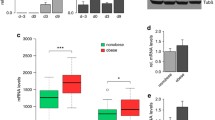Abstract
An important question about adipogenesis is how master adipogenesis factors (defined as being able to initiate adipogenesis when expressed alone) peroxisome proliferator-activated receptor (PPAR) initiate adipogenesis only in differentiating preadipocytes. The objective of our research was to find previously unidentified factors that are unique or highly enriched in cells of the adipocyte lineage during adipogenesis that may provide functional tissue specificity to preadipocytes. We reasoned that such factors may alter expression profile specifically in obese individuals. Omental adipose tissues were obtained from obese and non-obese male patients undergoing emergency abdominal surgery. mRNAs extracted from either group were used for suppression subtraction hybridization (SSH). Genes corresponding to mRNAs enriched in obese versus non-obese patients were identified through sequencing and further analyzed for tissue distribution. Out of ~20 genes, we found several that showed clear fat cell specific expression patterns. In this study, we functionally studied one of these genes, previously designated as open reading frame C10orf116. Our data demonstrated that C10orf116 is highly expressed in adipose tissue and is localized primarily within the nucleus. Over-expression studies in 3T3-L1 cells indicated that it up-regulates the levels of CCAAT/enhancer binding protein α (C/EBPα) and PPARγ and promotes adipogenic differentiation starting from the early stage of adipogenesis. Over-expressed in omental tissues from obese patients, C10orf16 manifested the characteristics of an adipocyte lineage-specific nuclear factor that can modulate the master adipogenesis transcription factors early during differentiation. Further studies of this factor should help reveal tissue-specific events leading to fat cell development at the transcriptional level.
Similar content being viewed by others
References
Cristancho AG et al (2011) Forming functional fat: a growing understanding of adipocyte differentiation. Nat Rev Mol Cell Biol 12:722–734
Esposito F et al (2009) Interaction between HMGA1 and retinoblastoma protein is required for adipocyte differentiation. J Biol Chem 284:25993–26004
Farmer SR et al (2004) Adipose tissue: new therapeutic targets from molecular and genetic studies–IASO Stock Conference 2003 report. Obes Rev 5:189–196
Galic S et al (2010) Steinberg, adipose tissue as an endocrine organ. Mol Cell Endocrinol 316:129–139
Gomez-Ambrosi J et al (2004) Gene expression profile of omental adipose tissue in human obesity. FASEB J 18:215–217
Gregoire FM et al (1998) Understanding adipocyte differentiation. Physiol Rev 78:783–809
Haslam DW et al (2005) Obes Lancet 366:1197–1209
Larose M et al (2001) A new gene related to human obesity identified by suppression subtractive hybridization. Int J Obes Relat Metab Disord 25:770–776
Melillo RM et al (2001) Critical role of the HMGI(Y) proteins in adipocytic cell growth and differentiation. Mol Cell Biol 21:2485–2495
Meruvu S et al (2011) Regulation of adipocyte differentiation by the zinc finger protein ZNF638. J Biol Chem 286:26516–26523
Ntambi JM et al (2000) Adipocyte differentiation and gene expression. J Nutr 130:3122S–3126S
Qiu J et al (2007) Identification of differentially expressed genes in omental adipose tissues of obese patients by suppression subtractive hybridization. Biochem Biophys Res Commun 352:469–478
Quach JM et al (2011) Zinc finger protein 467 is a novel regulator of osteoblast and adipocyte commitment. J Biol Chem 286:4186–4198
Rankinen T et al (2006) The human obesity gene map: the 2005 update. Obesity (Silver Spring) 14:529–644
Selvey S et al (2001) Beta-actin–an unsuitable internal control for RT-PCR. Mol Cell Probes 15:307–311
Steppan CM et al (2001) The hormone resistin links obesity to diabetes. Nature 409:307–312
Author information
Authors and Affiliations
Corresponding authors
Additional information
Yuhui Ni and Chenbo Ji contributed equally.
Rights and permissions
About this article
Cite this article
Ni, Y., Ji, C., Wang, B. et al. A Novel pro-adipogenesis factor abundant in adipose tissues and over-expressed in obesity acts upstream of PPARγ and C/EBPα. J Bioenerg Biomembr 45, 219–228 (2013). https://doi.org/10.1007/s10863-012-9492-6
Received:
Accepted:
Published:
Issue Date:
DOI: https://doi.org/10.1007/s10863-012-9492-6





